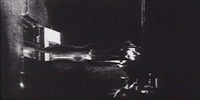Film is empirically defined as 24 frames per second. However, if the functional variables were to be transposed such that each frame instead represented 24 seconds of a fixed space (defined by the bounds of the frame) – the shift in perspective would capture a behaviorally dissimilar relational interval – a spatial “snapshot” that illustrates the visual continuum of time rather than a continuum of visible space (as in a photograph). From a fixed angle camera, the transposition would result in rotating objects that conflate into a flat map survey of the entire surface contour of the object (as in satellite mapping), dynamic motion that is revealed perpendicular to the line of sight as static objects disappear within the frame of the visible temporal “space”, relative motion that seemingly elongates and compresses along the traversal axis. This referential transposition from distance-time (x-t) (or position-time) to time-distance (t-x) drives the technology behind the surreally fluid, ethereal, metamorphosing images captured in Virgil Widrich and Martin Reinhart’s short film, tx-transform. Adapted from British mathematician and philosopher Bertrand Russell’s “accessible reference” analogy on Albert Einstein’s Theory of Relativity, the illustration posits that if two gunmen walked up to the two ends of a moving train and subsequently fired at the train conductor and the guard (located at the front and rear of the train respectively), a passenger riding in the railcar exactly located in the middle of the train would hear both shots at the same time, while a station master positioned between the two gunmen on the ground would hear the shooting of the guard first. Applying t-x transform at the moment of the assassinations, the resulting effect is one of organic, ghostly otherworldliness that reinforces the relativistic and amorphous relationship between space and time, revealing a curious, existential plasticity that seemingly captures an ephemeral instance that is imperceptible within a conventional, spatial frame: the moment of a soul’s physical transcendence.
© Acquarello 2005. All rights reserved.
